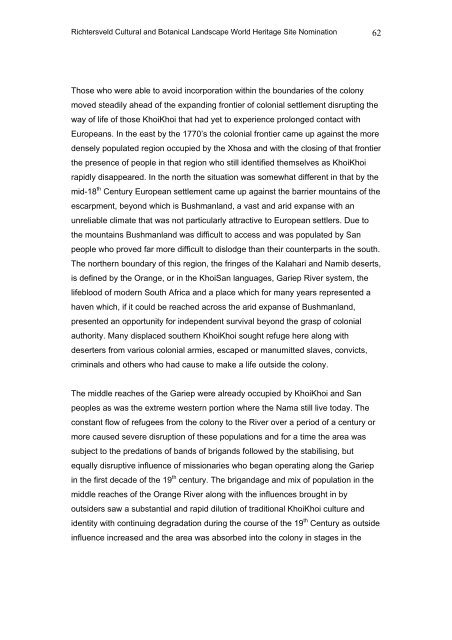the richtersveld cultural and botanical landscape - SAHRA
the richtersveld cultural and botanical landscape - SAHRA
the richtersveld cultural and botanical landscape - SAHRA
You also want an ePaper? Increase the reach of your titles
YUMPU automatically turns print PDFs into web optimized ePapers that Google loves.
Richtersveld Cultural <strong>and</strong> Botanical L<strong>and</strong>scape World Heritage Site Nomination 62<br />
Those who were able to avoid incorporation within <strong>the</strong> boundaries of <strong>the</strong> colony<br />
moved steadily ahead of <strong>the</strong> exp<strong>and</strong>ing frontier of colonial settlement disrupting <strong>the</strong><br />
way of life of those KhoiKhoi that had yet to experience prolonged contact with<br />
Europeans. In <strong>the</strong> east by <strong>the</strong> 1770’s <strong>the</strong> colonial frontier came up against <strong>the</strong> more<br />
densely populated region occupied by <strong>the</strong> Xhosa <strong>and</strong> with <strong>the</strong> closing of that frontier<br />
<strong>the</strong> presence of people in that region who still identified <strong>the</strong>mselves as KhoiKhoi<br />
rapidly disappeared. In <strong>the</strong> north <strong>the</strong> situation was somewhat different in that by <strong>the</strong><br />
mid-18 th Century European settlement came up against <strong>the</strong> barrier mountains of <strong>the</strong><br />
escarpment, beyond which is Bushmanl<strong>and</strong>, a vast <strong>and</strong> arid expanse with an<br />
unreliable climate that was not particularly attractive to European settlers. Due to<br />
<strong>the</strong> mountains Bushmanl<strong>and</strong> was difficult to access <strong>and</strong> was populated by San<br />
people who proved far more difficult to dislodge than <strong>the</strong>ir counterparts in <strong>the</strong> south.<br />
The nor<strong>the</strong>rn boundary of this region, <strong>the</strong> fringes of <strong>the</strong> Kalahari <strong>and</strong> Namib deserts,<br />
is defined by <strong>the</strong> Orange, or in <strong>the</strong> KhoiSan languages, Gariep River system, <strong>the</strong><br />
lifeblood of modern South Africa <strong>and</strong> a place which for many years represented a<br />
haven which, if it could be reached across <strong>the</strong> arid expanse of Bushmanl<strong>and</strong>,<br />
presented an opportunity for independent survival beyond <strong>the</strong> grasp of colonial<br />
authority. Many displaced sou<strong>the</strong>rn KhoiKhoi sought refuge here along with<br />
deserters from various colonial armies, escaped or manumitted slaves, convicts,<br />
criminals <strong>and</strong> o<strong>the</strong>rs who had cause to make a life outside <strong>the</strong> colony.<br />
The middle reaches of <strong>the</strong> Gariep were already occupied by KhoiKhoi <strong>and</strong> San<br />
peoples as was <strong>the</strong> extreme western portion where <strong>the</strong> Nama still live today. The<br />
constant flow of refugees from <strong>the</strong> colony to <strong>the</strong> River over a period of a century or<br />
more caused severe disruption of <strong>the</strong>se populations <strong>and</strong> for a time <strong>the</strong> area was<br />
subject to <strong>the</strong> predations of b<strong>and</strong>s of brig<strong>and</strong>s followed by <strong>the</strong> stabilising, but<br />
equally disruptive influence of missionaries who began operating along <strong>the</strong> Gariep<br />
in <strong>the</strong> first decade of <strong>the</strong> 19 th century. The brig<strong>and</strong>age <strong>and</strong> mix of population in <strong>the</strong><br />
middle reaches of <strong>the</strong> Orange River along with <strong>the</strong> influences brought in by<br />
outsiders saw a substantial <strong>and</strong> rapid dilution of traditional KhoiKhoi culture <strong>and</strong><br />
identity with continuing degradation during <strong>the</strong> course of <strong>the</strong> 19 th Century as outside<br />
influence increased <strong>and</strong> <strong>the</strong> area was absorbed into <strong>the</strong> colony in stages in <strong>the</strong>

















